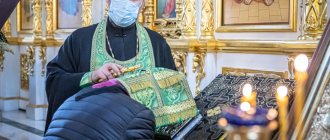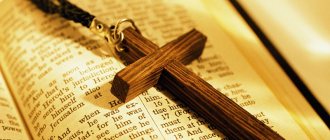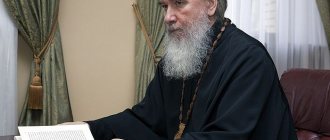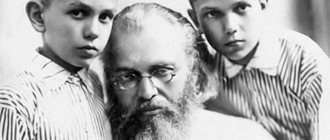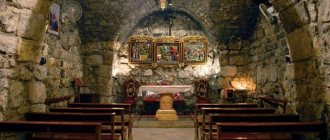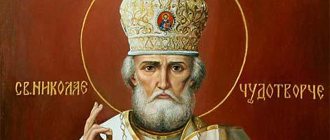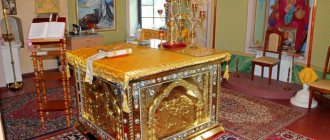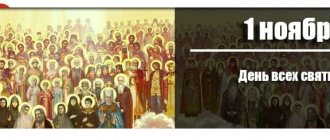Worship is an important part of any religion. During worship, people should feel that they are communicating with God during the service. And divine services must be unified so that any priest can conduct the service, and so that the laity can freely come to any church. It is also necessary to bring church life to a single denominator. The Church must be united and all its members must live by the same rules.
“And we came to the Greek land, and led us to where they serve their God, and we did not know whether we were in heaven or on earth: for there is no such sight and such beauty on earth, and we do not know how to tell about it, “We only know that God is with the people there, and their service is better than in all other countries.”
The Tale of Bygone Years
For this purpose, they began to create liturgical charters, or, in Greek, typikons.
Typikon refers to both the liturgical charter in general and a specific book with a specific charter
The origins of Christian liturgical regulations are in Judaism
The first Christian communities were part of the Jewish religion. The law that Christ came to fulfill was given by God to the Jews. Therefore, early Christian services were almost identical to Jewish services.
The first Christians fully observed Jewish traditions.
Jewish worship was divided into temple and synagogue. During the service, the psalms were first read, then a prayer that glorified the greatness of God. Then they read the Law and the Prophets. The service ended with a blessing.
The Eucharist - communion with bread and wine - has become the main sacrament of the Christian religion
Christ himself began to preach in synagogues. Everywhere He speaks about the fulfillment of the Law and denounces those who violate it.
But at the same time He announced the New Testament. He gave the Lord's Prayer, which should be read, and gave the most important thing - the sacrament of the Eucharist - a rite during which a Christian eats the Body and Blood of Christ and thus unites with God.
Judaism and Christianity finally diverged in the 2nd century.
In apostolic times, the duality of worship, the combination of the Old and New Testaments, is clearly manifested. However, there were no uniform rules for performing divine services.
In the VI century. The Jerusalem Charter appears - the main church charter of the Orthodox Church
By the 6th century different types of worship services begin to gradually come to a common denominator. Gradually, more or less similar rules for conducting rituals and services are developed.
In the ancient monastery of St. Savva the Sanctified, they adopted a charter that is used by all modern Orthodox churches
In 524, in the Lavra of Sava the Sanctified, the monks adopted a charter, which then spread throughout the Christian East. The charter for the monastery was written by Savva the Sanctified himself.
The Lavra of Saint Sava the Consecrated is located next to Jerusalem, so the charter received the name Jerusalem.
The charter was quite strict, because Savva wrote it for the monks. The original version of the charter has not survived.
Shah Khosrow devastated Palestine during the war with Byzantium. The first edition of the Jerusalem Charter perished in the fire of war
From the 9th to the 11th centuries. the main liturgical charter was the Studite
The Jerusalem Rule was quite strict and not entirely suitable for the laity. In the 8th century Theodore the Studite, abbot of the Studite monastery in Constantinople, wrote a charter for it.
The Studite monastery was founded in the 5th century, so the Studite monastery is considered older than the Jerusalem one.
The Studio Rules differed from the Jerusalem Rules in their greater simplicity and liberality. There are no all-night vigils, monks are allowed to choose their own abbot, and one can leave monasticism without hindrance. The rules of fasting were also not as strict as in the Jerusalem Charter.
The Studite monastery has existed since the 5th century, but the charter that has come down to us was written by Theodore the Studite in the 8th century.
The complete original of the Studite Charter, recorded in the Studite Synaxar, has not survived. The oldest list is Hypotiposis, and the most complete edition of the Studite Charter has come down to us as part of the Typikon of Patriarch Alexei Studite.
The synaxarion is a book with liturgical instructions for the year, an integral part of the typikon.
The capture of Constantinople by the Crusaders in 1204 marked the final end to the dominance of the Studite Rite.
In Georgia, before the transition to the Jerusalem Charter, they used the studio Typikon of George Mtatsmindeli
Orthodox Life
Reflections of Priest Andrei Chizhenko.
On the one hand, the Church Charter is a set of rules necessary for an Orthodox Christian to follow. But, as Mikhail Skaballanovich, professor of the Kyiv Theological Academy, aptly noted in his book “Explanatory Typikon,” this is not all. We need to look deeper...
Here, it seems to me, an extensive quotation from the Kyiv theologian should be given in full:
The meaning of the word "Typikon"
In every book, its title is very important. A good title of a book immediately shows the reader what new things he will find in it, and even leads to a solution to the question to which the book is devoted. The book, now called the Typikon, previously bore other names, for example, the common one and now the “Charter”. Its current name has been developed over the centuries, and this already indicates that it should be thoughtful and significant. – Being an adjective from τύπος - trait, type, sample, model, norm, τυπικός means “composed according to a model,” but it is not the same with άντίτυπος, snapshot, copy. Therefore, in Russian, the word τυπικός somewhat corresponds to the word “exemplary”, if the latter is used in the sense of “most corresponding to its example.” Τυπικόν, which implies βιβλίον, book, can mean “book of samples”, samples of something obvious. Only in one Orthodox Church does a book outlining the order of worship bear such an original title. It is untranslatable into Slavic, which is why it was left without translation. The word "charter" would be an inaccurate rendering of the Greek τυπικόν ("charter" corresponds to the Greek διάταξις).
Meaning of the title
Such a title skillfully defines the nature of not only the book from which it is adopted, but also the very service of worship in which this book deals. In relation to this divine service, a book with such a title does not so much want to legitimize its slightest particulars, eliminating any freedom of the senders in it, but rather wants to draw a high ideal of divine service, which with its beauty would evoke an always involuntary desire for its implementation, perhaps to the fullest extent. and not always possible, like the implementation of any ideal, the following of any high model. This, in essence, is the whole law of Christ, not fully realized in all its heavenly heights, but with its divine greatness arousing an uncontrollable desire in humanity for its implementation and through this life-giving peace.
That is, the Charter, the typikon, is not only rules of conduct understood in a legal sense, but a heavenly ideal to which one must strive. This is development, dynamics, constant improvement of a person in communication with God. The Charter should in no way become a concentration camp; on the contrary, it is called by the grace of the Holy Spirit through the works of the Holy Fathers to free the human soul in order to help it communicate with God. From the Charter, as Metropolitan Anthony of Sourozh said, one should not make an idol, an idol. He is blessed because he is a ladder to Heaven. It is a blessed means for comprehending God, but not an end in itself.
Roughly speaking, for example, Sergei Bubka reached a height of about six meters. The average person who wants to do high jumping is told: you should too. This is the charter. Forward. He flies and breaks his neck because, without preparation, he decided to do something for which a trained athlete had been preparing himself for years, and perhaps decades.
Demanding that new Orthodox Christians fulfill all the norms of the charter is about the same as demanding instant fruit from a newly planted apple tree seed. The fruit will appear only after a few years, and if the agronomist decides differently, he will destroy the plant.
The Holy Chief Apostle Paul speaks directly about this: “We should talk a lot about this; but it is difficult to interpret, because you have become unable to listen. For, judging by the times, you should have been teachers; but you again need to be taught the first principles of the word of God, and you need milk, not solid food. Everyone who is fed on milk is ignorant of the word of righteousness, because he is a child; solid food belongs to the perfect, whose senses are trained by skill to distinguish between good and evil” (Heb. 5:11-14).
That is, the apostle says that there are levels in the spiritual development of a person. New “babies” need verbal “milk” that is understandable to them, and already churchgoers can take “solid” food. You can’t give a baby solid food right away, his stomach will stop. He needs to be prepared for it.
In this sense, Orthodoxy is life, constant improvement. Orthodoxy is growth. And you cannot invade this growth without thinking or rashly, with excessive zeal, because you will disrupt this life or, God forbid, interrupt growth. It is better to trust the experienced church “vinedressers” who are appointed by God to control this growth, observe it, and help it. These are the clergy.
Choose a priest according to your heart and consult with him. Living according to advice is great wisdom, as the holy fathers say.
Let us remember, dear brothers and sisters, that silence is often more important than words. And the word hurts more than a straight razor. If you want to advise something, first look: is there love in your heart for this person, is there an understanding of his biography, the internal laws of his life (after all, a person is the whole world!), can you put yourself in his place, remember, what were you like at his age or as a neophyte? One of the main rules of pedagogy is that the teacher himself must be a little bit of a child and, as it were, lower his adult mind to the level of development of a child, speaking in his language. He should remember what he was like at that age. And so, when you do not mechanically cut off the norm of the statute - one, two, third, and so on (such as: don’t stand here, don’t stand there, etc.), but as if you penetrate into the life of another person, consider the Holy of Holies in him, the image and likeness of God, be imbued with love for him, then you can give advice.
We must remember that everything starts with love. This is the main norm of the Church Charter.
Priest Andrey Chizhenko
Parallel to the regulations for monks, there were regulations for laity
Liturgical practice in monasteries differed from liturgical practice in parish churches. Neither parish priests nor parishioners could carry out the strict monastic rules.
The history of secular statutes is poorly known. Only the Constantinople Charter of the Great Church has reached us.
The secular charter known to us was drawn up at the main church of the Byzantine Empire - Hagia Sophia. Therefore, the charter was called the Charter of the Great Church
There is no disciplinary part in the charter, and divine services are particularly solemn; singing in them prevailed over reading.
The basis of the service was synapti - common prayers of the clergy and laity.
The charter of the Great Church disappeared along with Byzantium, other secular charters were replaced by the Jerusalem one.
Protopsalt Constantine tried to create a new secular charter in 1838. He created the Typikon of the Great Church of Christ. He took the same Jerusalem Charter as a basis.
Protopsalt is the main singer.
In 1888, protopsalt George Violakis revised the typicon of Constantine. The new typikon was called the Violakis Typikon and is now used in Bulgaria and, partly, in Greece.
Religion:
In the first centuries of the Russian Church
Before acquiring autocephaly in the 15th century, the Russian Orthodox Church, as one of the metropolises of the Patriarchate of Constantinople, was guided by the same “Nomocanons” as the Church of Constantinople; all decisions of its Councils, Patriarchs and Synods were binding on the Russian Church. The most authoritative sources of ancient Russian church law during this period were the letters of the Ecumenical Patriarchs on the affairs of the Russian Church, compiled in the form of messages to Russian metropolitans, bishops, and princes.
At the same time, as an autonomous metropolis of the Patriarch of Constantinople, the Russian Church also carried out its sovereign legislative activities within the limits of this autonomy. The local bodies of church lawmaking were primarily the Councils. In addition to conciliar decrees, canonical messages and responses of metropolitans and diocesan bishops also belong to the monuments of church legislation of ancient Rus'.
The uniqueness of Russian history during the period of dependence of the Russian Church on the Patriarch of Constantinople was expressed in the fact that the church legal documents of state origin in force in Rus' during this era were issued by different authorities: local grand-ducal and appanage princely authorities, Byzantine emperors and Golden Horde khans.
The legislation of the Russian princes, naturally, makes up a large part of the ecclesiastical legal material. The so-called princely charters, in contrast to the laws of the Byzantine emperors, practically do not affect intra-church life, but only concern the relationship between the Church and the state: most often they list the benefits provided to the Church. The most important monuments of domestic law are the Charter of St. Vladimir and the Charter of Yaroslav the Wise; they were included in the Russian handwritten “Helmsmen’s Books”, which contained a set of regulations of the life of that time - both secular and church.
Some charters of the Byzantine emperors on Russian church affairs have also been preserved, but the participation of the emperors in the church life of Rus' was very limited both due to its political independence from Constantinople and due to the geographical remoteness of the Russian land.
Much more noticeable was the dependence of our Church on the Golden Horde, which enslaved Rus'. The Mongol khans gave the Russian metropolitans so-called labels. When appointed, each metropolitan had to ask the khan to confirm the previous one or issue a new label. It is characteristic that the labels not only confirmed the privileges of metropolitans, bishops and clergy that existed before the conquest of Rus', but also expanded them compared to the previous ones. As the researchers noted, “the khans protected the inviolability of faith, worship, laws, courts and the property of the Church, exempted all clergy from all kinds of taxes and duties, and granted the spiritual authorities the right to judge their people in all civil and criminal matters.”
Statutes of life of the autocephalous Russian Church
With the beginning of the autocephalous existence of the Russian Church, the sources of Russian church law remained unchanged: the “Nomocanon” in the form of the “Helmsman’s Book”, decrees of Councils, canonical answers and messages of hierarchs, “Charters” of St. Vladimir and Prince Yaroslav the Wise. The main church legislative body was the Local Councils.
The Council of 1551, convened under St. Macarius, Metropolitan of Moscow, and under Tsar Ivan the Terrible, is of great historical significance. The subjects of the conciliar deliberations were outlined in 69 questions proposed by the tsar. The Council issued a Code divided into 100 chapters. Hence its name - “Stoglav”, which was transferred to the Cathedral itself. The Code touches on the main aspects of church life; it collected and systematized all the norms of the current law of the Russian Church.
After the establishment of the Patriarchate in Moscow in 1589, the Local Council convened the following year issued an act with a charter from the Patriarch of Constantinople Jeremiah II on the election of Job as Patriarch and on the Patriarchal title of his successors. This act is placed at the beginning of the printed “Helmsman’s Book”.
A number of Stoglav’s decisions canceled the Great Moscow Council of 1667, convened under Tsar Alexei Mikhailovich. The Great Moscow Council expressed the norm of relations between church and state authorities as follows: the Tsar has priority in political affairs, and the Patriarch in church matters. The resolutions of the Council are mentioned as valid laws in the “Spiritual Regulations”, which marked the beginning of the Synodal period, and were included in the “Complete Collection of Laws of the Russian Empire”.
The Council of 1675 established provisions on the advantages and differences of the Patriarch, metropolitan, archbishop, bishop and other hierarchical persons.
In addition to the cathedral decrees, bishops' letters, archpastoral messages and teachings, also relating to the period under consideration, have reached us. Some of these documents were subsequently included in the “Complete Collection of Laws of the Russian Empire” of 1830, and therefore, they retained legal force in the 19th century.
Church legal relations were also regulated by state legislation. In Muscovite Rus', in addition to the Consecrated (church) Councils, Zemsky Councils were convened. Thus, the Code adopted by the bicameral Council and published in 1649 included chapters devoted to church affairs.
Synodal period
At the beginning of the 18th century, a difficult and controversial period began in the history of the Russian Church. After the death of Patriarch Adrian, Emperor Peter I prohibited the election of a new Patriarch, and the Church in Russia was ruled for two decades by a Locum Tenens, then a Spiritual College was established with the emperor as the “ultimate Judge of this College.” Soon the Spiritual College was renamed the Holy Synod.
The most important church-legal monument of the era, on which the foundations of the synodal system of church governance are based, is the “Spiritual Regulations”, compiled by Bishop Feofan (Prokopovich) in 1719, signed by the Consecrated Council and approved by Peter I in December 1720.
The Regulations consist of three parts. The first part, entitled “What is a spiritual collegium and what are the important advantages of such government?”, gives a general idea of the collegial form of government and explains its advantages in comparison with individual power. The main argument here is the danger of dual power in the state. The second part, entitled “Affairs of Administration Subject to This,” describes the range of affairs subordinate to the newly established church government. It also speaks in general terms about the duties of bishops, priests, monks and laity. In the third part - “The position and power of the stewards themselves” - the composition of the Spiritual College and the duties of its members are determined.
In 1722, as an addition to the “Spiritual Regulations,” an “Addendum on the Rules of the Church Clergy and the Order of Monasticism” was compiled, which contains entire statutes on the parish clergy and monasticism. The document was also supplemented by instructions to the Chief Prosecutor of the Synod. In 1841, the “Charter of Spiritual Consistories” approved by the Synod was first published, thoroughly revised four decades later. This is a kind of “Spiritual Regulation” of the diocesan administration.
Restoration of the Patriarchate on the eve of the most severe persecution of the Church
The canonical defectiveness of the synodal system burdened the conscience of bishops, clergy and laity. In the second half of the 19th century, the need to transform the church system began to be discussed publicly. The church people have hope for the convening of an All-Russian Local Council. In the minds of people who were especially painfully worried about the non-canonical nature of the synodal government, the idea of restoring the Patriarchate is ripening.
The specially established Pre-Conciliar Presence prepared materials for the upcoming Local Council, but the Tsar considered the convening of the Council untimely. In 1912, the materials of the Presence were revised by the Pre-Conciliar Conference, but again the matter did not come to the convening of the Council. Only the abdication of the emperor opened the way to the Local Council. In 1917, the Pre-Conciliar Council, chaired by Archbishop Sergius, prepared the “Regulations on the All-Russian Local Council.”
The Local Council of the Russian Orthodox Church, held in 1917-1918, was an event of epochal significance. By abolishing the canonically flawed and completely outdated synodal system of church government and restoring the Patriarchate, he paved the line between two periods of Russian church history. The main goal of the Council was to organize church life on the basis of full-blooded conciliarity, and in completely new conditions, when, following the fall of the autocracy, the previous close union of Church and state disintegrated. Therefore, the themes of the conciliar acts were predominantly church-organizing and canonical in nature.
With the restoration of the Patriarchate, the transformation of the entire system of church government was not completed. The brief Definition of November 4, 1917 was subsequently supplemented by a number of detailed definitions about the bodies of the highest church authority: “On the rights and duties of His Holiness the Patriarch of Moscow and All Russia”, “On the Holy Synod and the Supreme Church Council”, “On the range of affairs to be carried out” bodies of the highest church administration”, “On the procedure for electing His Holiness the Patriarch”, “On the Locum Tenens of the Patriarchal Throne”.
These definitions constituted the real code of the Russian Orthodox Church, which replaced the “Spiritual Regulations”, “Charter of Spiritual Consistories” and a whole series of more specific legislative acts of the synodal era.
The Council endowed the Patriarch with rights corresponding to canonical norms, primarily the 34th Apostolic Canon and the 9th Canon of the Antioch Council: to take care of the well-being of the Russian Church and represent it before the state authorities, to communicate with the autocephalous churches, to address the all-Russian flock with teaching messages, to take care of timely replacement bishops' sees, to give fraternal advice to bishops. The Patriarch received the right to visit all dioceses of the Russian Church and the right to receive complaints against bishops. According to the Definition, the Patriarch is the diocesan bishop of the Patriarchal region, which consists of the Moscow diocese and stauropegic monasteries. The administration of the Patriarchal region under the general leadership of the First Hierarch was entrusted to the Archbishop of Kolomna and Mozhaisk.
Local Council 1917-1918 formed two bodies of collegial government of the Church in the period between the Councils: the Holy Synod and the Supreme Church Council. The competence of the Synod included matters of a hierarchical-pastoral, doctrinal, canonical and liturgical nature, and the jurisdiction of the Supreme Church Council included administrative, economic, school and educational matters. And finally, particularly important issues related to the protection of the rights of the Russian Orthodox Church, preparation for the upcoming Council, and the opening of new dioceses were subject to decision by the joint presence of the Synod and the Supreme Church Council.
The Supreme Church Council did not exist in the Russian Church for very long. Already in 1921, due to the expiration of the three-year inter-council term, the powers of the members of the Synod and the Supreme Church Council elected at the Council ceased, and the new composition of these bodies was determined by the sole Decree of the Patriarch in 1923. By the Decree of Patriarch Tikhon of July 18, 1924, the Synod and the Supreme Church Council were disbanded.
The life of the Russian Church under the yoke of an atheistic state
In May 1927, Deputy Locum Tenens Metropolitan Sergius (Stragorodsky) established the Provisional Patriarchal Synod. But this was only an advisory institution under the First Hierarch, who then possessed all the fullness of the highest church power.
On September 8, 1943, the Council of Bishops opened in Moscow, which included three metropolitans, eleven archbishops and five bishops. The Council elected Metropolitan Sergius Patriarch of Moscow and All Rus'.
In 1945, a new Local Council was held, at which Metropolitan Alexy (Simansky) of Leningrad was elected Patriarch. The Council issued a brief Regulation on the Russian Orthodox Church of 48 articles, which replaced the Definitions of the Council of 1917-1918. There is an undoubted continuity between the legislative acts of the two Local Councils, but the changes made, due to the circumstances of the time, based on the invaluable experience experienced by the Church, consisted, in general, in emphasizing the hierarchy of the church system. The “regulations” of the 1945 Council expanded the competence of the Patriarch, diocesan bishop, and parish rector
Unlike the documents of the Council of 1917-1918, in the said Regulations our Church is not called Russian, but, as in ancient times, Russian.
The Holy Synod, according to the Regulations on the Administration of the Russian Orthodox Church of 1945, differed from the Synod formed in 1918 in that it did not share its power with the Supreme Church Council and had a different composition, and from the Provisional Synod under the Deputy Locum Tenens it differed in the presence of a real power, since it was not only an advisory body under the First Hierarch.
The Council of Bishops, held in 1961, revised the Statute of the Russian Orthodox Church as it relates to parish administration; clergy were removed from the management of the material resources of the parishes, which was now entrusted exclusively to parish meetings and parish councils, headed by their chairmen-elders. This decision was approved in 1971 by the Local Council, at which Metropolitan Pimen (Izvekov) of Krutitsky and Kolomna was elected Patriarch of Moscow and All Rus'.
A new period of historical existence of the Russian Orthodox Church
The Local Council, held in 1988 - the year of the millennium of the Baptism of Rus' - issued the Charter of the Russian Orthodox Church. It regulated the structure of higher, diocesan and parish administration, the activities of theological schools and monasteries in incomparably more detail than in the “Regulations on the Russian Orthodox Church”. The “Charter” incorporated the principles of the church system that have stood the test of life, which formed the basis of the “Definitions” of the Local Council of 1917-1918. and the “Regulations” issued by the 1945 Council.
This document became the basic law of our Local Church for twelve years, and in 2000, according to the decision of the Jubilee Council of Bishops, it was replaced by a new Charter, which also undergoes changes over time, reflecting changes in the life of the Russian Church.
The current Statute of the Russian Orthodox Church was adopted by the Jubilee Council of Bishops in 2000. The document contained provisions regulating the activities of the Russian Orthodox Church as a Local Autocephalous Church, located in doctrinal unity and prayerful and canonical communion with other Local Orthodox Churches. The Charter talks about the procedure for convening and working of the Local Council and the Council of Bishops, their status and powers; a separate chapter is devoted to the activities of His Holiness the Patriarch of Moscow and All Rus'.
The document also contains provisions concerning the activities of the Holy Synod, the Moscow Patriarchate and Synodal institutions, and the church court. The Charter also contains provisions regulating the establishment and functioning of self-governing Churches within the Moscow Patriarchate, and lists the currently existing self-governing Churches, and considers issues related to the activities of the Exarchates of the Russian Orthodox Church, the establishment and functioning of the Metropolitan Districts within the Moscow Patriarchate.
The Charter regulates the activities of dioceses of the Russian Orthodox Church, deaneries, institutions of the Russian Orthodox Church in foreign countries; issues of the creation and functioning of parishes and monasteries, the work of educational institutions of the Russian Orthodox Church, as well as other issues relating to church administration and the activities of church institutions are regulated.
Changes to the Charter were previously made by the Determinations of the Councils of Bishops in 2008 and 2011.
The Consecrated Council of Bishops of 2013, having studied the proposals of the Inter-Council Presence to clarify the powers of the Local and Bishops' Council of the Russian Orthodox Church, to determine the rules for electing the Patriarch of Moscow and All Rus', as well as on the composition of the Local Council, issued a Determination on the adoption of a new edition of the Statute of the Russian Orthodox Church. In addition, the Holy Synod adopted a number of decisions requiring amendments and additions to the Charter of the Russian Orthodox Church. In particular, these are decisions on the establishment of the Central Asian Metropolitan District, on the creation of the Supreme Church Council, on the formation of metropolises, on the formation of diocesan vicariates, on changes in the composition of the Holy Synod. These changes are reflected in the new edition of the Charter. Together with the new edition of this document, the Council approved the Regulations on the election of the Patriarch of Moscow and All Rus' and the Regulations on the composition of the Local Council of the Russian Orthodox Church.
The article uses materials from the book “Church Law” by Archpriest Vladislav Tsypin
Photo by the press service of the Patriarch of Moscow and All Rus'
Source
The full rules of worship were recorded in writing in the 11th century. Nikon Montenegrin
By the 11th century. there were 2 branches of statutes: Studite, based on the statute of Theodore the Studite, and Jerusalem, based on the statute of Savva the Sanctified. Nikon Chernogorets took charge of editing and drawing up a unified charter. He found out that there are different editions of the same typikons, with various disagreements among themselves. At the same time, the existing disagreements did not have any serious significance.
Order of 12 Psalms
an echo of the ancient monastery charters
There were two significant differences: all-night vigils on Sundays and holidays and the singing of the Great Doxology at Matins.
In fact, almost everything was ready in order to bring together everything available in the Christian church. After researching all the typikons available to Nikon Montenegrin, he took the Jerusalem one as a basis. There were several reasons:
- The Jerusalem Rule contained references to Holy Scripture. This gave the statute more authority. There are no such references in the Studio Charter.
- The lists with the text of the Jerusalem Rule were older than the lists with the text of the Studite Rule.
- The Jerusalem Rule is stricter than the Studite Rule.
From the 12th century The Jerusalem Charter begins to gradually supplant the Studite Charter. In the 12th century The Jerusalem Charter was adopted in Greece and Georgia in the 14th century. - in Serbia and Bulgaria, in the 15th century. - in Rus'.
TERRITORY OF PATRIOTISM
12 theses of the churching of an Orthodox person. (My version of the “rule of faith”, that is, the standard of churching that missionaries need to be equal to when converting a person to Christ)
1. The goal of an Orthodox person’s life is the Kingdom of Heaven. The martyrs get there through death for Christ, the saints - through the feat of monastic self-sacrifice, while we, who live in the world, get there through complacent patience of sorrows and the desire to glorify God.
2. A Christian is a disciple of Christ, therefore he constantly remains at the feet of his Teacher, recognizing his destiny in the Creator’s plan, imitating the Lord and learning from Him humility and love in the Holy Spirit. A disciple of Christ always strives to learn, reads books, observes the destinies of God, delving into himself and the teaching of the Gospel.
3. Every day a Christian communicates with God. When a Christian prays, he turns to God, when a Christian examines Scripture through the prism of the teachings of the Holy Fathers, God turns to a Christian. So, we pray and read Scripture every day and this is the simplest and most reliable form of communication with God.
4. At least once every three weeks, a Christian must begin the sacrament of St. Communions. (See Rule 80, Rule 6 of the Ecumenical Council). In order to receive communion not for condemnation, but for salvation, active repentance is necessary. This is facilitated by participation in the sacrament of confession, the struggle with passions, self-reproach and attention to oneself.
5. Worship once a week. “Six days you shall work, and do all your work; and the seventh day is the Sabbath of the Lord your God.” (Ex. 20:4). We have 168 hours a week. Of these, we must give at least 24 hours to God. There are 4 ways to give time to God: Prayer, reading Scripture, communication with faithful Christians, Eucharist (Liturgy at which bread is broken). (See Acts 2:42).
6. The "tithe" rule. Set aside at least one tenth of your income every month and give it away with joy. This money will be used to maintain the temple, to charity within the community and to support counseling within the community.
7. Rule of fidelity. A Christian is faithful... • To his elderly parents, helping them in their old age, • To his spouse, caring for his life partner as if he were the Lord Himself, • To his children, caring about their future, cultivating in them love for Christ, for His Church, and also to His teaching and His saving work in the world. • The Church, maintaining canonical unity with Her through submission to its hierarchy, • His friends in the Church, • God, and this loyalty is expressed in the fulfillment of the Gospel commandments.
8. Rule for sharing experience. As you know, whoever you hang out with is the one you gain. A Christian cannot have spiritual contact with a principled atheist. But a Christian must have constant communication with people faithful to God to exchange experiences of spiritual life.
9. The rule of the relay of care within the community of the faithful. A pastor-counselor cares for his community through a “relay of care.” He directly takes care of the “novices” of his community, his “novices” take care of the new Christians, and they take care of the perishing people of the godless world. Take your place in this relay of care.
10. Rule of 4%. There are so many true Christians in our country. All Christians, without exception, must testify to the love of God to this world to the best of their ability.
11. Rule of honest work. Every Christian must work, first of all, for the sake of obedience to the Lord, for since the Fall, work “by the sweat of our brow” has been an important condition for our spiritual life. And secondly, we must work to take care of our neighbors and do works of mercy.
12. Rule of sobriety and sobriety. Don’t get drunk on wine, don’t get drunk, keep yourself away from drugs, smoking, pornography, computer and Internet addiction. Be sober and chaste, carefully using what the Lord has given us, remembering that the world is evil.
The typicon consists of two sections
The typicon is divided into 2 sections of 60 chapters. The first section is divided into 3 parts:
- Chapters 1-46. This part contains general instructions about divine services and sacred rites.
- Chapters 47-51. It contains instructions about the signs of the holidays and the order of performing divine services for the Menaea of the month. The 48th chapter - Monthly - is the largest in the entire Typikon.
- Chapters from 52 to the end. It contains additions to the remaining chapters, as well as some changing prayers and chants and information about their use in services.
The second section is divided into:
- Temple Chapters, 1-58. Here is how to perform worship on temple holidays.
- Choruses for 9 Songs of the Holy Scriptures – chapter 59.
- Easter and Lunar - table with phases of the Moon - chapter 60.
Applicability of the Typicon
It should be noted that the Typikon is a generally accepted liturgical ideal, which sometimes even monasteries do not strive to fulfill exactly. Always focusing on Him, in parish practice, however, the following are usually partially or completely reduced from the daily circle of services: small vespers (before the all-night vigil), kathismas, psalms, stichera, paremias, lithium, compline, midnight office, hallelujah service, two psalms, sedalny, power antiphons, biblical songs, canons, synaxariums, inter-hours, blessed, apostolic and evangelical conceptions, remembrance of health and for repose at the Liturgy, litany of catechumens, Rite of Panagia, 9th hour and a number of individual prayers. And vice versa, non-statutory akathists, prayer services, and memorial services are included in general church services almost every day. The Typikon sometimes allows for a certain freedom of choice:
| “If the abbot pleases...” |
The Typikon not only offers the procedure for performing church-wide services, but also reveals theological truths and inspires the ascetic life, prayer, obedience, abstinence, patience, charity, love and other Christian virtues. The authority of the Typikon in the Orthodox Church is so great that all clergy, before being ordained to sacred degrees, take an oath with a promise to observe the Church Charter (Typikon), individual chapters of which were read at meals in monasteries along with the teachings of the Holy Fathers of the Church.
the Liturgical Instructions for each year (in the already traditional purple hard covers) became widespread in the Russian Orthodox Church In this regard, not every Orthodox church in Russia has a Typikon.
In Russia, worship is conducted according to the Jerusalem Rule
Rus' was baptized during the reign of the Studio Charter. Therefore, the Studite Charter became the first liturgical charter in Rus'. Theodosius of Pechersk approved it in the Kiev Pechersk Lavra, from where it spread to all Russian monasteries.
The beauty of rituals and worship greatly influenced Prince Vladimir’s choice of faith
The Jerusalem Charter appeared in Rus' in the second half of the 14th century, after it was translated into Church Slavonic. In the 15th century it supplanted the Studite Rule and became the basis of Russian Orthodox worship.
In Rus', the Jerusalem Charter was called “The Eye of the Church,” according to a translation of 1401.
In Russia, the Jerusalem Charter was published in printed form in 1610. In 1695, a new edition of the typikon was published, which is used in the Russian Church for worship to this day.
For divine services in the Russian Orthodox Church they use the Typikon of 1695 with minor editions
By leaving a comment, you accept the user agreement
Basic provisions of the charter
Of the latest adopted statutes, the Russian Orthodox Church is guided by the document adopted at the Jubilee Council of Bishops in 2000. The edition of the last charter underwent some changes in subsequent years. Thus, amendments were made in 2008, 2011, 2013, 2016, 2022.
Church charter - rules that govern the activities of the church
The provisions of the charter regulate various aspects of the Church’s activities:
- As an Autocephalous Local Church, the Orthodox Russian Church maintains contact with other Local Churches of the same denomination and is in doctrinal unity with them.
- The charter also defines the procedure for convening the Bishops' and Local Councils, their powers and responsibilities.
- The activities of the Patriarch are the subject of discussion in a separate chapter of the charter.
- In addition, the document includes information about the activities of the Holy Synod, synodal institutions and the Moscow Patriarchate, and regulates the work of the church court.
- This resolution approves the procedure for the formation and subsequent activities of new self-governing churches under the jurisdiction of the Moscow Patriarchate.
- The charter lists all currently existing churches.
- The issues of the activities of the Exarchates and Metropolitan Districts subordinate to the Moscow Patriarchate are examined in detail.
- Within the framework of the charter, provisions are established that define the rules for conducting activities by dioceses, deaneries, and organizations of the Russian Orthodox Church abroad.
- The Charter plays a regulatory role in matters of the creation and functioning of monasteries, educational institutions of the church and other issues relating to all aspects of the life of such organizations.
Important!
In 2013, on the basis of proposals made by the Inter-Council Presence, the Consecrated Council of Bishops adopted a new edition of the Charter of the Russian Orthodox Church. Changes were made regarding the existing powers of the Local and Bishops' Councils, the rules for electing the Patriarch and the composition of the Local Council. Read about the activities of the Church:
- Why do the Orthodox have so many churches?
- Does the Church pay taxes?
- Why and for what does the Church collect money?
